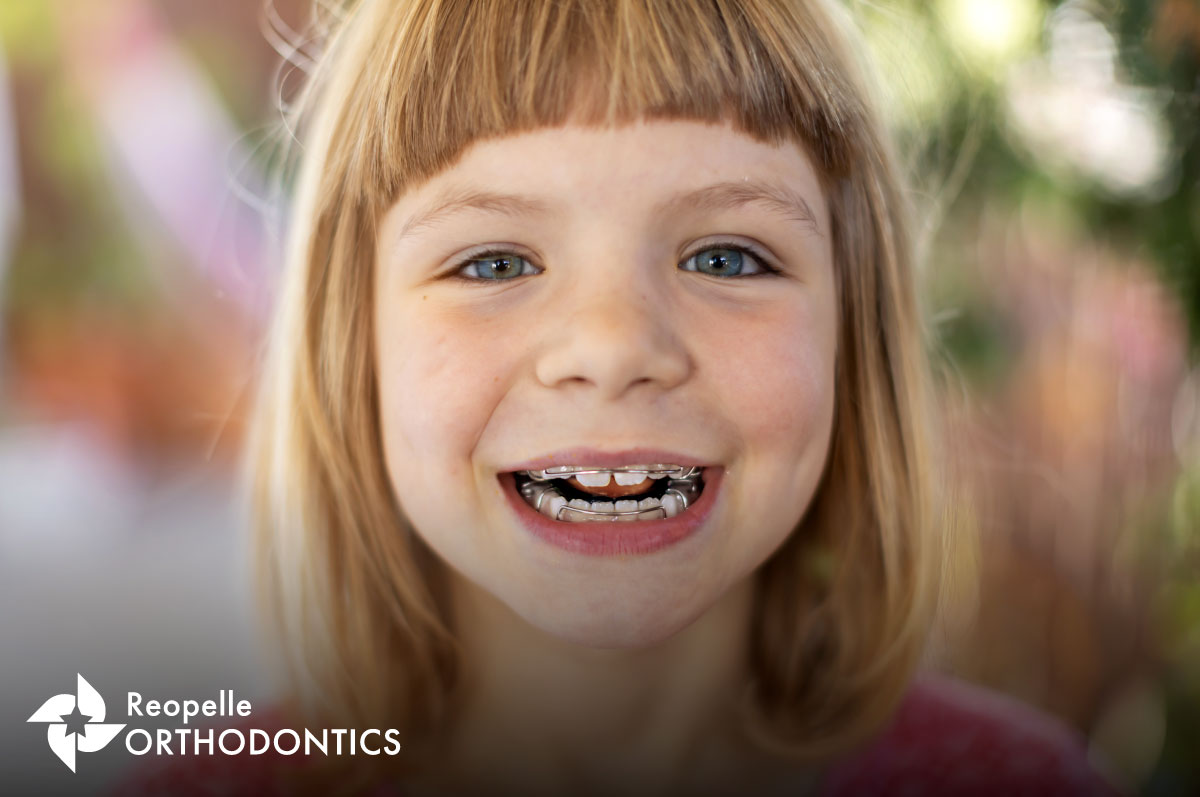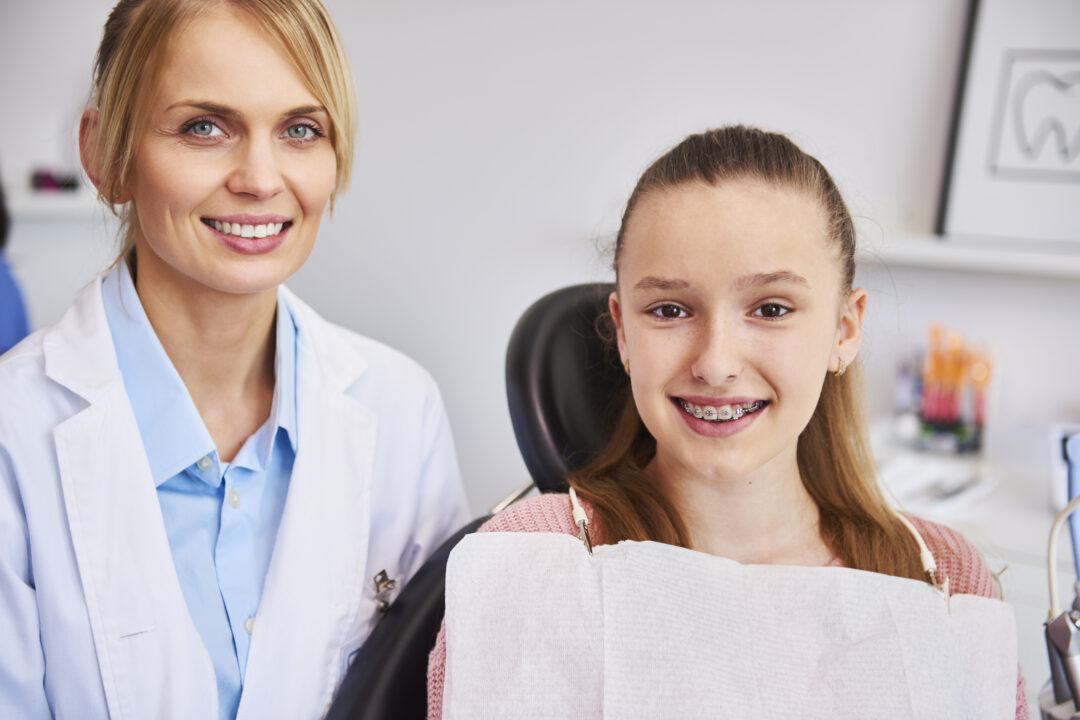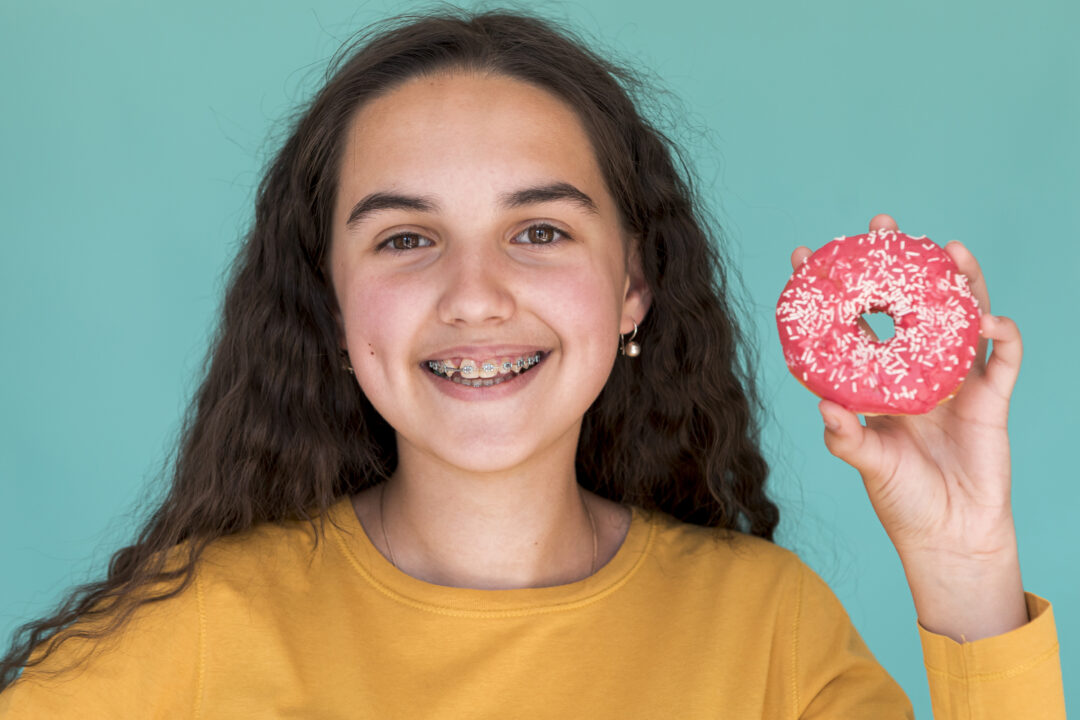What Age Does My Kid Need Braces?

There is no definite answer to this question. When we talk about braces, parents tend to imagine it as the utter and final solution. However, orthodontics goes beyond braces. There are several phases to complete that, despite being unknown, start at an early age.
Also, when we refer to orthodontic treatment as in any other health-related setting, a therapy or treatment has a higher degree of success if treated on time. Therefore, before intending to get braces for a kid, it is primordial to evaluate the need for early interceptive treatment (two-phase treatment).
In other words, we should first consider our little patient’s needs when we think of braces. Then, to elucidate a plan, a pediatric orthodontist performs a case evaluation to define the need for braces.
Sometimes, the orthodontist takes a “wait and see” approach, holding up until all permanent teeth sprout. Conversely, other cases require immediate action with orthodontic appliances that, in some circumstances, include palatal expanders, or they might directly opt for braces after concluding there is an inadequate tooth and bite progression.
Therefore, to have a clearer idea of when my child will get braces and if she needs them, it might be better to detail the control and diagnosis phases that outline the activities to follow as your kid grows.
What Is Two-phase Orthodontic Treatment?
Orthodontics is a lot about “planning.” This means that making important decisions requires following a phased process that aims to achieve a result. The outcome is getting a healthy, functional, and beautiful smile with the lower hassle possible.
But sometimes, avoiding hassle is difficult as some factors come in the specialist’s way. With this in mind, a pediatric dentist might first encounter some dental advancement issues and treat them to guide the full development of teeth and jaws at a very early age.
Consequently, a two-step orthodontic process initiates with an observation that is also a part of the entire course of action. Here we detail the procedure:
Stage 1: Earlier Treatment
First, there is an initial consultation. We encourage parents to schedule a first pediatric dentist visit at age 2. Then, during years 2 to 6, the pediatric dentist will observe the kid’s evolution of the dental arches to figure out “early” corrective measures.
The aim at this stage is to mainly devise and shape space for teeth (baby teeth and later mature teeth) to grow in their adequate position.
But, What Does a Pediatric Dentist Observe in Kids To Define Them as Candidates for Stage 1 Early Treatment?
A pediatric dentist observes the following patterns:
- Hardship at biting (abnormal bite);
- Losing baby teeth too early;
- When jaws click or grind when moving them;
- Kids with signs of bruxism and;
- When a kid breathes by the mouth.
In this phase, the pediatric dentist works in coordination with parents to eliminate some habits that could have a negative impact on adulthood. For instance, thumb-sucking or using a pacifier for a long time might cause future orthodontic problems.
Back to the question of at what age does my kid needs braces? The pediatric dentist might recommend using a space maintainer or other appliances to model proper teeth space for actual and growing teeth.
Stage 2: Middle Dentition
We can define this stage as the first orthodontic phase. The American Association of Orthodontists – AAO, recommends parents take their kids to their first orthodontic evaluation no later than seven.
Accordingly, this phase extends from ages 6 to 12. The main objective is to reorient erratic jaws in kids. During this age span, your kid might show signs of potential crossbite.
Also, some permanent teeth start to sprout, and the orthodontist might require to use orthodontic appliances such as a palatal expander to grow the jaws to make space for braces in Stage 3 orthodontics, and to guide teeth to their correct position.
At this stage, and according to the little patient’s needs, an orthodontist might recommend using braces or clear aligners like Invisalign First.
What Makes This Phase So Crucial When It Comes To Orthodontic Treatment?
First, depending on the Orthodontist evaluation, your kid might start using braces or clear aligners. Secondly, your kid enters a maturity level where its jaws (hard and soft tissue) are manageable to start routing further teeth progression and avoiding future malocclusion.
A characteristic of this stage is to route teeth development to the next level. Orthodontists work according to the kid’s age. And at this stage, two things might occur.
First, the specialist might not need to suggest using orthodontic appliances and advise parents to wait for the full development of mature teeth.
In a second stance, a pediatric orthodontist backs their decision to use orthodontic appliances when noticing the possibility of developing a severe malocclusion.
Stage 3: Adolescent Dentition
This stage might start immediately after the later part of Stage 3. At age 13, It might be more convenient for a kid to start using braces or clear aligners “depending on the type and severity of the malocclusion.”
Furthermore, in early adolescence, mouth tissues remain malleable, and most of the permanent teeth erupt. After proper compliance and tractability of previous stages, at Stage 3, the orthodontist might be able to reduce treatment trauma.
In this stage, the main objective is to realign permanent teeth and work on obtaining a functional and aesthetic smile. To picture this stage, an orthodontist might have already created space for upcoming problematic teeth in previous stages.
Are Kids’ Braces Worth It?
Yes, kids’ braces are worth it. After a first pediatric orthodontist evaluation, if there is considerable evidence of future severe malocclusion, your little one might be a candidate to wear braces early.
Your little kid’s orthodontist may want to hold until permanent teeth sprout to start orthodontic treatment in Roanoke. However, as we previously discussed in some serious and
inexorable cases, recurring to braces at an early age might be the wisest path to follow.
Indeed, working early reduces the chance of a more traumatic treatment later on, and it might help create space for overcrowded teeth, correct a bad bite, improve jaw alignment
In summary, an orthodontist might also recur to braces on baby teeth to mark a path for permanent teeth to sprout in a guided manner.
Options for Kids’ Braces
The most significant part is the convenience of choosing from an array of options and types of pediatric braces for your kid. You can play a bit with colors and in some cases having braces is trendy at school, and your kid might be begging to have braces.
Whatever the case is, here we have a shortlist of some of the most popular options of orthodontic braces and removable appliances for kids today:
Traditional Braces
Contrary to adults’ preferences, in some cases, kids might prefer metal braces and be able to choose rubber band colors and interchange them every once in a while.
Clear Ceramic Braces
It might occur your kid does not like having metal in the mouth and don’t want to feel self-conscious. A great option to solve this problem is to opt for Clear Ceramic Brackets that mimic teeth color.
Invisalign
It is the latest advancement in orthodontic removable aligners technology, comfort, and hygiene and might be optimal for its discretion if your kiddo doesn’t want their classmate’s note the appliances.
However, a drawback is that your kid might lose the trays at school. Fortunately, Invisalign First has a solution and includes a spare set for every two-week appliance.
Early Interceptive Treatment At Reopelle Orthodontics
We invite you to schedule an appointment at Reopelle Orthodontics. We will gladly take care of your little kid and ensure to exhaustively evaluate and communicate its need to start early intervention and prepare a comprehensive orthodontic treatment plan for a healthy smile.



